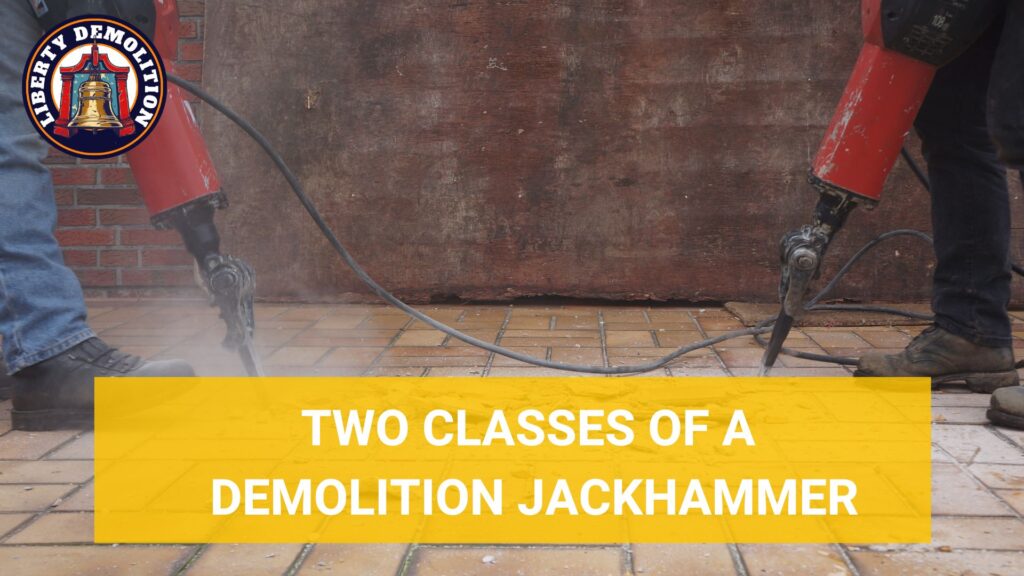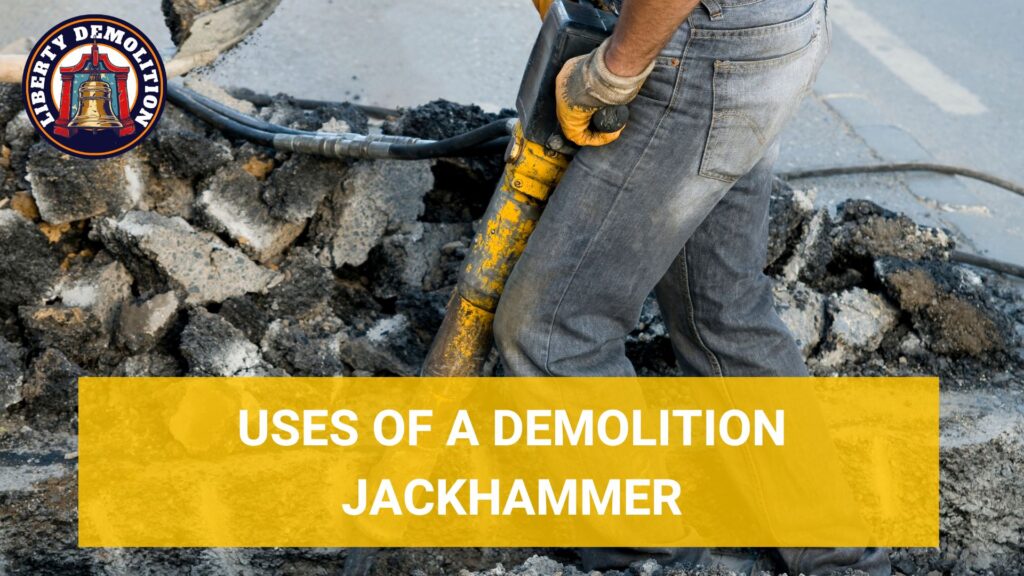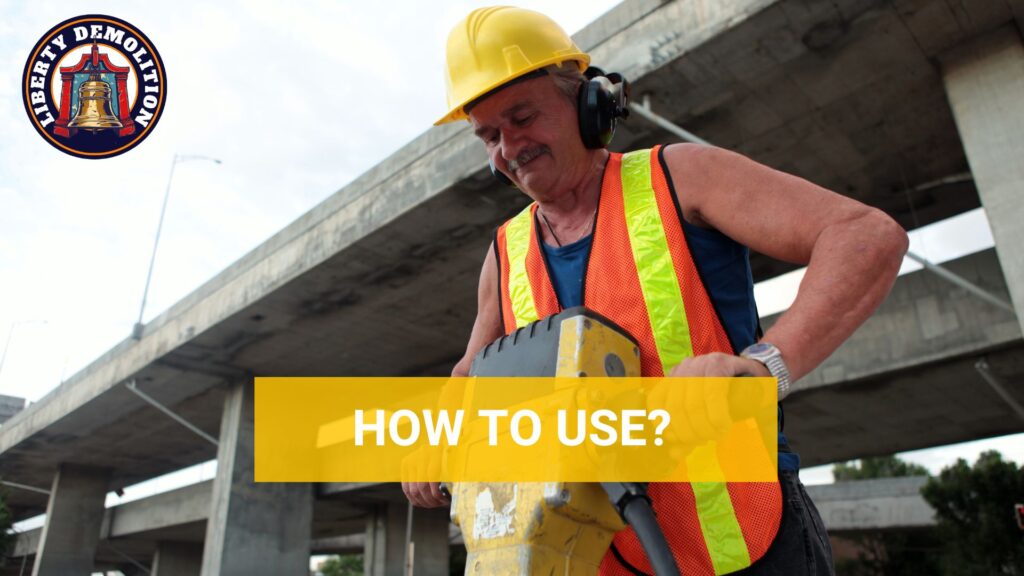A demolition jackhammer is a powerful, electric or pneumatic tool designed to break up hard materials such as concrete, brick, and asphalt. Its chisel-like bit operates at high speeds, delivering rapid, concentrated impacts to fracture and disintegrate surfaces.
Do you want to know more about this tool? Let’s discuss all you need to learn about a demolition jackhammer to maximize its use and know the best products you can choose from.
What Is a Demolition Jackhammer?
A demolition jackhammer, often simply called a “jackhammer,” is an important tool on many construction and demolition sites. Think of it as the heavyweight champion in the toolkit. Where regular hammers and even sledgehammers fail, this beast powers through.
A demolition jackhammer is all about force and speed. It operates either on electricity or compressed air. The motor or air drives a piston, which creates a rapid series of blows to the attached bit. This constant, high-powered pounding allows the jackhammer to break through tough materials that other tools can’t touch.
A basic jackhammer is a large, elongated machine with a sturdy grip at one end and a sharp, chisel-like bit at the other. However, modern jackhammers often come with additional features like vibration controls, ergonomic handles, and even cooling systems to prolong the tool’s life.
While the name “demolition” jackhammer might give it away, this tool isn’t just for tearing things down. It’s important for tasks like:
- Breaking up old driveways or sidewalks
- Trenching for utilities or plumbing
- Removing tiles or flooring
- Demolition work on larger structures

Two Classes of a Demolition Jackhammer
Here are the two main classes of this tool. What you’ll need depends on the job at hand:
Hydraulic Jackhammers
Hydraulic jackhammers operate using a hydraulic system. It functions based on the principle of hydraulics, where liquid (typically oil) is pressurized to produce motion. When the fluid is forced into the jackhammer’s cylinder, it drives the piston forward, creating a powerful hammering action.
Hydraulic jackhammers are most commonly seen on large construction sites, especially where substantial excavation or heavy demolition is required. Due to their enormous power, they’re often mounted on machinery such as backhoes or excavators.
Benefits of Using Hydraulic Jackhammers
- Power: They can tackle heavy-duty tasks with ease.
- Efficiency: Hydraulic systems are often more efficient than their pneumatic counterparts. They deliver consistent power, so the job gets done faster.
- Reduced Noise: While no jackhammer is truly ‘quiet,’ hydraulic models tend to produce less noise compared to the traditional pneumatic ones.
Limitations of Hydraulic Jackhammers
- The primary limitation is size and mobility. Given that they’re often mounted to heavy machinery, they’re not suitable for smaller, more intricate tasks.
Handheld Jackhammers
Handheld jackhammers are more portable and can be operated manually by a single individual. These tools can either be electric or pneumatic. They convert energy (from an electric motor or compressed air) into rapid hammering movements that chip away at surfaces.
Handheld jackhammers are versatile and can be used in a wide range of jobs, from breaking up a small patch of concrete in a backyard to chiseling out tiles in a renovation project.
Benefits of Using Handheld Jackhammers
- Portability: They can be transported easily and used in areas larger machinery can’t access.
- Flexibility: With different attachments and bits available, handheld jackhammers can be adapted for various tasks.
- Cost-effective: Compared to the larger hydraulic models, handheld jackhammers are generally more affordable.
Limitations of Handheld Jackhammers
- Power and endurance are the main limitations of handheld jackhammers. They’re not cut out for breaking up thick concrete expanses or prolonged heavy-duty use.

What Is a Demolition Jackhammer Used For?
Demolition jackhammers have many applications, each serving a unique purpose in construction and remodeling projects:
Breaking Concrete and Asphalt
- Roadworks: Jackhammers break old, damaged asphalt in preparation for resurfacing.
- Foundation Work: Foundations in need of repair or modification often require sections of concrete to be broken up. Jackhammers make this task far more efficient than using manual methods.
Trenching
For utilities, pipes, or cables, digging trenches in solid grounds, especially if it’s concrete or hard-packed earth, can be challenging. Jackhammers are used to create precise trenches without expending excessive manual labor.
Demolition Work
- Building Demolition: In situations where buildings or structures need to be torn down, jackhammers play an important role in chipping away at walls, pillars, and floors.
- Removing Internal Structures: For buildings being refurbished, old internal walls, pillars, or other structures may need to be removed to make way for new designs.
Tile and Flooring Removal
Jackhammers, especially the smaller handheld models with specific chisel attachments, can be used to lift tiles and strip away old flooring with relative ease.
Sculpting and Artistic Work
While less common, some artists use jackhammers for sculpting large pieces, especially in stone or concrete mediums.
Mining and Quarrying
In the mining industry, jackhammers, often called rock drills, are used to break and remove rock. They help create tunnels, extract minerals, or prepare a site for further excavation.

How to Use a Demolition Jackhammer
Handling a demolition jackhammer requires understanding, precision, and, most importantly, safety.
Choose the Right Type of Demolition Jackhammer
Selecting the appropriate jackhammer will significantly impact the efficiency of the job and your safety.
1. Understand Your Job Needs
Larger tasks, such as major demolition or deep trenching, might require the power of a hydraulic jackhammer, especially if mounted on machinery. A handheld model is more appropriate for smaller jobs like tile removal or minor concrete breakage.
Electric jackhammers are the preferred choice for indoor jobs or areas without proper ventilation due to the lack of emissions. Pneumatic or hydraulic models can be considered on outdoor sites with wide space.
2. Hydraulic vs. Handheld
- Hydraulic Jackhammers: Consider these when dealing with large-scale demolition or excavation.
- Handheld Jackhammers: Lightweight and more maneuverable, these are great for more delicate or precision tasks.
3. Assess Tool Features
Modern jackhammers come equipped with a variety of features designed to enhance efficiency and user comfort:
- Vibration Control: Prolonged use of jackhammers can lead to strain and fatigue. Models with vibration control reduce the impact on the user.
- Ergonomic Design: Features like padded handles and balanced weight distribution can make a significant difference during extended use.
- Variable Speed Controls: Some tasks may require different speeds. Models with variable speed controls allow users to adjust the intensity of the hammering action.
4. Choose the Right Bit or Chisel
- Spade: Great for digging through soil or clay.
- Flat Tip: Ideal for breaking up flat concrete surfaces.
- Pointed Tip: Useful for breaking up rocks or creating starting points in concrete.
Step-by-Step Procedure
Using a demolition jackhammer efficiently and safely requires a systematic approach. Here’s a step-by-step guide to help you get started:
1. Safety First
- Wear protective gear: This includes safety goggles, ear protection, heavy-duty gloves, and steel-toed boots.
- Clear the area: Ensure that only those involved in the operation are present. Keep bystanders at a safe distance.
2. Set Up Your Jackhammer
Install the chosen bit or chisel into the jackhammer. Make sure it’s securely fastened. For pneumatic jackhammers, connect the air hose and ensure there are no leaks. For electric models, plug into a power source.
3. Position the Jackhammer
Place the tip of the bit or chisel on the surface you intend to break. Hold the jackhammer at a slight angle – about 15 degrees from the vertical.
4. Begin Operation
Start the jackhammer at a low speed (if variable speed) and gradually increase as needed. Apply consistent downward pressure, but let the tool do most of the work. Avoid forcing it too hard into the material.
5. Work in Sections
Focus on one small area at a time. This ensures efficient breaking and minimizes the risk of unexpected cracks or splinters.
6. Turn Off and Rest
If using for extended periods, take regular breaks to prevent overheating of the tool and fatigue for the operator.
7. Finish and Clean Up
Once you’ve achieved the desired results, turn off the jackhammer, remove the bit, and safely store the tool. Clear away debris and ensure the workspace is safe.
Techniques for Using a Demolition Jackhammer
Knowing the right technique can improve the efficiency of a jackhammer and reduce physical strain on the operator:
1. Work from the Edges
If possible, begin at an edge or a corner. It’s usually easier to start breaking from an existing edge than from the center.
2. Use Short Bursts
Instead of keeping the jackhammer running continuously, use short bursts of power. This reduces the risk of the bit getting stuck and minimizes fatigue.
3. Maintain Proper Stance
Stand with your legs shoulder-width apart for balance. Lean into the jackhammer slightly, but maintain control.
4. Rotate the Tool
When trying to break through tough spots, slightly rotate the jackhammer left and right. This can help dislodge the material more effectively.
5. Avoid “Dry Firing”
Running the jackhammer without contact with a surface can damage the tool. Always ensure the bit is against the material before starting.
6. Clear Debris Regularly
Make sure you always have a clear view of the working area so you can assess progress.
How Long Should You Be on a Jackhammer?
Prolonged exposure to a jackhammer’s vibrations and physical demands can lead to health issues and fatigue. Here’s what you need to know about the duration of jackhammer use:
1. Health Considerations
Prolonged use of a jackhammer can potentially lead to a condition known as Hand-Arm Vibration Syndrome (HAVS). HAVS is a health disorder caused by regular and frequent exposure to hand-arm vibration. Symptoms can include tingling, numbness, and even loss of hand strength. It’s essential to be aware of this and manage the time spent on a jackhammer to reduce the risk.
2. Duration Recommendations
It’s advisable to use the jackhammer in short bursts rather than prolonged sessions. A good rule of thumb is to operate the tool for 15-20 minutes and then take a 5-minute break. Try not to exceed 2 hours of cumulative use in a day. This time might be less for more massive machines or more strenuous tasks.
3. Listen to Your Body
While the above are general guidelines, individual tolerance can vary. If you start to feel tingling, numbness, or excessive fatigue, it’s a sign to take a break regardless of the time spent.
4. Other Considerations
- Task Complexity: The time you can spend on a jackhammer can also depend on the complexity of the task. Breaking through a thick slab of reinforced concrete can be more taxing than chipping away at a thin layer of asphalt.
- Environmental Factors: Working in extreme temperatures, either hot or cold, can affect the duration you can comfortably and safely operate the jackhammer.
How Long Does it Take to Break Up Concrete with a Jackhammer?
Breaking up concrete might sound like a long, difficult task, but the process becomes significantly more manageable with a jackhammer in hand. However, the time taken can vary based on several factors:
Thickness of the Concrete
- Thin Slabs (less than 4 inches): These can be broken relatively quickly, often in mere minutes per square foot.
- Standard Driveway or Sidewalk (around 4-6 inches): This might take a bit longer, with estimates ranging from 5 to 15 minutes per square foot, depending on reinforcement and concrete strength.
- Thick Concrete Slabs (more than 6 inches): These are more time-intensive, potentially taking upwards of 20-30 minutes or more per square foot.
Type of Jackhammer
- Handheld Jackhammers: Suitable for smaller tasks or areas where precision is needed. While they’re portable and maneuverable, they might take longer on thick slabs.
- Hydraulic Jackhammers: These are mounted on machinery and offer more power, making them ideal for thicker slabs or large areas. They can speed up the process considerably.
Reinforcements in the Concrete
Concrete that’s been reinforced with steel bars (rebar) or mesh can be more time-consuming to break. The jackhammer can easily break the concrete, but cutting through or working around the metal reinforcements can add to the time.
Operator Experience
An experienced operator can work more efficiently, correctly positioning the jackhammer, adjusting the angle as needed, and effectively using the tool’s power.
Concrete Age and Condition
Older concrete can be easier to break, especially if it’s showing signs of wear, cracking, or weather damage. Conversely, newly poured concrete that’s been properly cured might offer more resistance.
Common Mistakes In Using Jackhammer
While incredibly efficient at what they do, jackhammers can also pose risks if not used correctly.
Mistakes
- Neglecting Safety Gear: One of the most common mistakes is not wearing the appropriate safety gear. This oversight can lead to immediate injuries, long-term health concerns, or both.
- Overexertion: Applying more force to the jackhammer may speed up the process, but it can also damage the tool and pose a greater risk to the operator.
- Ignoring Manufacturer’s Guidelines: Every jackhammer is slightly different. Ignoring the guidelines provided by the manufacturer can result in inefficient use or even damage the tool.
- Not Checking for Utilities: It’s a grave mistake to start breaking ground without checking for underground utilities such as water, gas, or electric lines.
- “Dry Firing” the Jackhammer: Running the jackhammer without it being in contact with a surface can wear out the tool faster.
- Inadequate Maintenance: Not properly cleaning or maintaining the jackhammer can reduce lifespan and effectiveness.
- Using the Wrong Bit: Different tasks require different bits. Using the wrong one can slow down progress and potentially damage the surface.
How to Avoid Them
- Always wear safety goggles, ear protection, gloves, and steel-toed boots. OSHA’s guidelines on pneumatic tools emphasize the importance of personal protective equipment.
- The jackhammer’s design allows its weight and power to break through surfaces. Instead of forcing it down, guide and allow it to do the heavy lifting.
- Always read the manufacturer’s manual before using the tool.
- Use utility locators or get in touch with local utility companies to mark out any underground lines before you begin.
- Always ensure the jackhammer’s bit is in contact with the surface before starting.
- Clean the jackhammer after every use.
- Familiarize yourself with different bits and chisels to ensure you always use the right tool for the task.
Safety Tips on Using a Jackhammer
While jackhammers are incredibly powerful tools, they can also be dangerous if not used correctly.
Wear a Personal Protective Equipment (PPE)
The importance of PPE can’t be overstated. It protects the operator from potential risks and hazards associated with jackhammer operation. Always be equipped with PPEs, such as safety goggles, ear protection, heavy-duty gloves, steel-toed boots, a dust mask or respirator, and a hard hat.
Inspect Your Jackhammer Regularly
Routine checks and maintenance of the jackhammer ensure its efficient operation and enhance safety.
- Check for Wear and Tear: Before using, inspect the jackhammer for any signs of wear, damage, or malfunction.
- Inspect the Bit: Ensure the bit or chisel is sharp, undamaged, and securely attached to the jackhammer.
- Test Before Full Operation: Before starting on the main task, give the jackhammer a brief test run. This allows you to identify any irregularities in its operation.
- Clean After Use: After each use, clean the jackhammer to remove dust, debris, and any other contaminants.
- Store Properly: When not in use, store the jackhammer in a dry and safe place.
5 Best Jackhammer Recommendations
Over the years, specific brands and models have established themselves as reliable and efficient. Here’s a roundup of some of the best jackhammers available in the market based on user reviews, expert opinions, and features:
1. Bosch BH2770VCD Brute Turbo Breaker Hammer
- Features: This electric jackhammer is known for its powerful 15-amp motor, which delivers an impressive 1,000 BPM (blows per minute). The Turbo Power feature gives more power in hammer-only mode, and the Active Vibration Control provides increased user comfort.
- Best For: Heavy-duty demolition jobs on concrete, asphalt, and masonry.
- User Feedback: Many users appreciate the tool’s durability and the reduced vibration, which minimizes user fatigue.
2. DEWALT D25901K 23.4 LB SDS Max Demolition Hammer
- Features: The DEWALT D25901K offers 12 adjustable positions, allowing users to optimize chiseling angles. It also features SHOCKS – Active Vibration Control, which significantly reduces vibration for less user fatigue.
- Best For: Medium to heavy-duty applications in concrete and masonry.
- User Feedback: Users have praised its power, efficiency, and ergonomic design, which ensure comfort during extended use.
3. Makita HM1307CB 35-Pound Demolition Hammer
- Features: The Makita HM1307CB boasts a powerful 14-amp motor that delivers 730-1,450 BPM. It also has an LED power light that indicates switch failure or cord damage and a constant speed control that automatically applies added power to the motor.
- Best For: Various demolition tasks, including breaking up concrete and other masonry materials.
- User Feedback: Many users highlight its long-lasting performance and consistent power output. The soft-start feature is also a hit, ensuring smooth start-ups.
4. Hilti TE 3000-AVR Jackhammer
- Features: Known for its impressive power-to-weight ratio, this electric jackhammer is comparable to many air breakers in terms of performance. Its Active Vibration Reduction (AVR) feature makes it one of the most comfortable electric jackhammers to operate.
- Best For: Heavy-duty demolition on walls and floors.
- User Feedback: Its power output comparable to pneumatic hammers is frequently praised. The reduced vibration levels make it a favorite among professionals for prolonged use.
5. TR Industrial TR89305 Electric Jack Hammer
- Features: This all-round electric jackhammer delivers 1,800 BPM with its 13-amp motor. It also comes with a 360-degree swivel auxiliary handle, giving users more flexibility.
- Best For: Home renovations and light to medium-duty demolition tasks.
- User Feedback: It’s praised for being a budget-friendly yet powerful option. Users also appreciate the inclusion of safety goggles, gloves, and hex keys in the package, which make it a great starter kit.
| Product Name | Pros | Cons |
| Bosch BH2770VCD Brute Turbo Breaker Hammer | Powerful 15-amp motor delivering 1,000 BPM. Turbo Power feature for added power. Active Vibration Control for user comfort. | Might be heavy for some users. Price can be on the higher side. |
| DEWALT D25901K 23.4 LB SDS Max Demolition Hammer | 12 adjustable positions for chiseling angles. SHOCKS – Active Vibration Control. Ergonomic design. | Requires occasional maintenance checks. Might be overkill for lighter tasks. |
| Makita HM1307CB 35-Pound Demolition Hammer | Powerful 14-amp motor with 730-1,450 BPM. LED power light indicator. Constant speed control. | Can be bulky for some users. Some users might find it noisy. |
| Hilti TE 3000-AVR Jackhammer | High power-to-weight ratio. Comparable to pneumatic hammers. Active Vibration Reduction (AVR). | Premium price tag. Heavier than some other models. |
| TR Industrial TR89305 Electric Jack Hammer | Delivers 1,800 BPM with a 13-amp motor. 360-degree swivel auxiliary handle. Comes with safety goggles, gloves, and hex keys. | More suited for light to medium-duty tasks. Longevity might not match premium brands. |
Get Your Demolition Job Done Faster
Whether breaking concrete, trenching for utilities, or removing old structures, the right jackhammer can make the job more efficient and manageable. 🔨 But if you want to get the job done faster and more efficiently, reach out to Liberty Demolition today. Our company offers comprehensive demolition services. ♻️ We prioritize safety, environmental responsibility, and customer satisfaction while efficiently managing waste and recycling for an eco-friendly solution.
Don’t hesitate to contact Liberty Demolition for all your demolition requirements and experience our commitment to excellence. Your construction or demolition project deserves the expertise and reliability our demolition contractors in Philadelphia can provide. Take the first step toward a successful project by calling us. Let’s talk business, and we’ll provide you with a free quote. 📞💼






